
Quick Summary:
- Governance, risk and compliance are the operating systems for project delivery discipline, value protection, and executive trust.
- Projects don’t fail due to a lack of frameworks but due to late, fragmented signals. Predictive intelligence closes that gap.
- Leaders who embed foresight into governance, risk, and compliance see fewer surprises, cleaner execution, and more confident boards, clients, and regulators.
Why Is Governance, Risk and Compliance Essential in Project Management?
Projects succeed or fail not just on technical execution but on the clarity of decisions made under pressure. This is where governance, risk, and compliance prove their worth. GRC is not about adding more layers of policy—it’s about turning ambiguity into accountable choices, risk posture into informed trade-offs, and compliance into disciplined delivery.
When governance is vague, risks are treated as static checkboxes, and compliance is left until the end, projects inevitably slip. McKinsey’s research on large IT programs shows the cost of such late signals—projects run about 45% over budget and 7% over schedule on average, while delivering far less value than intended. Per McKinsey’s 2025 Global GRC Benchmarking Survey echoes the problem: more than 70% of executives admit that current oversight models surface risks too late to prevent disruption. The message is clear—static frameworks are no longer enough. What’s required is predictive, real-time intelligence that equips leaders to intervene before problems escalate.
How does GRC clarify accountability and decisions?
Strong governance defines who decides what, when, and on which evidence. RACI charts and PMBOK® guardrails set the baseline, but the real test is adaptability—can decision rights flex as scope, stakeholders, and constraints shift?
Consider a global IT modernization program migrating legacy applications to the cloud across 15 countries. Instead of one static steering committee, it applied adaptive governance: smaller, empowered decision cells tied to business units and a central predictive project management dashboard that flagged emerging delays. When early signals showed vendor onboarding lagging in Asia-Pacific, governance protocols shifted decision rights temporarily to regional leads. The project met its milestones without budget overruns.
Gartner underscores this need for context-sensitive governance, noting that one-size-fits-all models are obsolete. Blending agile, hybrid, and waterfall portfolios requires governance that can flex without sacrificing control—something only possible when GRC is embedded with real-time visibility and predictive intelligence. Gartner
Why is risk central inside governance, risk and compliance?
Risk isn’t just a list—it’s a set of shifting probabilities building silently across scope, teams, integration, and change management. The real danger is rarely the “unknown unknowns,” but familiar signals that surface too late: over-allocated teams, fragile dependencies, or stakeholder drift that static risk registers fail to capture until costly rework is unavoidable.
What are the top risks in GRC for projects?
The most common flashpoints include:
- Resource overload that erodes delivery capacity.
- Integration gaps that create hidden dependencies.
- Stakeholder misalignment that triggers scope creep.
- Regulatory blind spots that lead to surprise compliance issues.
McKinsey’s 2024 GRC survey reinforces the stakes. While most boards oversee risk and maintain basic taxonomies, far fewer conduct stress testing, define risk appetite, or tie risk metrics to executive incentives. This maturity gap explains why static registers fall short—and why predictive, real-time decision-intelligence is essential to identify project risks before they escalate.

How does compliance earn trust inside governance, risk and compliance?
Compliance that surfaces only at the end of delivery often leads to costly rework and lost credibility. Harvard Business Review has long warned that “box-checking” programs fail because they emphasize ritual over effectiveness. The real test is whether verification is built into project workflows—showing discipline at every handoff, not just in post-audit reports.
McKinsey’s 2024 compliance benchmarks highlight the gap. Many organizations report strong policies, procedures, and training, yet far fewer embed active remediation, continuous monitoring, or board-level accountability. For project leaders, this means compliance cannot remain an afterthought. It has to function as evidence in motion—clear signals that commitments are being met as delivery unfolds. Predictive oversight strengthens this further, spotting gaps before they affect project quality or timelines, and creating a natural bridge to risk management. 
Where does predictive intelligence reshape governance, risk and compliance without overshadowing it?
Predictive GRC matters most where traditional oversight lags. Once governance structures, risk frameworks, and compliance baselines are defined, predictive tools should be embedded to strengthen them in real time:
- Convert lagging dashboards into leading signals (e.g., approval latency ↔ milestone risk).
- Quantify the probability of schedule, cost, or quality slippage—while decisions can still change the outcome.
- Surface behavioral cues such as sentiment shifts or engagement dips that governance alone may not capture.
Think of predictive as the amplifier, not the headline—it doesn’t replace governance, risk, and compliance; it makes them sharper, earlier, and more actionable.
Don’t wait for quality gaps to surface—see them ahead of time. Book your TrueProject demo now!
What Are the Core Pillars of Governance, Risk and Compliance in Project Management?
The pillars remain the same—governance (decisions and oversight), risk (uncertainty and impact), and compliance (conformance and assurance)—but the pace of delivery has changed. Each pillar now has to operate in real time across portfolios where funding gates, architectures, vendors, and policies move at different speeds.
How should governance operate without slowing delivery?
- Define who decides what—and at what threshold. For example, what a product owner can approve versus what requires an investment board.
- Timebox decisions with SLAs, escalation paths, and quorum rules to reduce “decision debt.”
- Share the same data across boards and delivery teams to ensure transparency.
Gartner notes that adaptive governance is essential—matching governance style to business context (innovation vs. standardization, speed vs. assurance) reduces friction without losing control.
How should risk be managed beyond a static register?
- Refresh probabilities and impacts weekly for the top 10 risks instead of waiting for quarterly reviews.
- For each critical risk, define the early indicator, the trigger, and a pre-approved response.
- Link every risk to cost, schedule, and quality so trade-offs are visible to decision makers.
McKinsey’s data—projects running 45% over budget on average—shows most pain is forecastable earlier if workload strain, dependency volatility, and change churn are tracked as first-class risks.
How should compliance work as proof, not paperwork?
- Build checkpoints into handoffs (requirements → design → build → test) instead of relying on audits later.
- Capture evidence once and reuse it across portfolio, audit, and client reviews.
- Measure outcomes—such as avoided rework, reduced defects, or preserved cycle time—rather than form completion.
Use it surgically:
- Governance – detect approval delays that signal missed gates; flag boards before slippage. A three-day SLA on approvals reduces “decision debt,” with predictive tools highlighting when cycle times drift past that threshold.
- Risk – track probability shifts from workload spikes, defect rates, or dependency churn. A 20% weekly rise in unresolved defects can sharply raise schedule-slip risk—predictive models capture it early so leaders can intervene in time.
- Compliance – auto-check artifacts at each handoff; alert teams only when evidence is missing. At the design-to-build handoff, automated checks prevent gaps that would otherwise cause costly rework two sprints later.
This is not more process; it’s timely signal—the minimum foresight that keeps momentum without micromanagement.
When the stakes are high, leaders need signal, not noise.Schedule a TrueProject discussion.
Where Does Governance, Risk And Compliance Break Down in Project Management?
Frameworks alone don’t prevent failure. PMI estimates 11.4% of every project dollar is wasted due to weak governance and risk practices. The problem isn’t lack of process—it’s that accountability, risks, and compliance are addressed too late to change the outcome.
Why does fragmented accountability weaken governance?
When roles and decision rights overlap, leaders hesitate or contradict one another. Decisions pile up, momentum stalls, and governance becomes theater instead of clarity. These bottlenecks rarely appear in dashboards until deadlines slip. Fast tracking approval cycle times and escalation delays gives leaders early visibility into weak governance.
Why is reactive risk management ineffective?
Most organizations keep static risk registers. They capture “known” risks but miss how fast those risks evolve. By the time metrics show shifts, teams are already firefighting. Effective risk management is continuous—tracking workload strain, shifting dependencies, and stakeholder sentiment—so leaders act weeks earlier, not after red flags appear.
Why does compliance collapse when it’s paperwork?
End-stage audits expose gaps when corrections are costly. By then, projects have already absorbed rework and reputational damage. Embedding compliance into workflows changes the dynamic—providing proof of commitments as delivery unfolds, not after the fact.
Projects rarely fail because frameworks are missing—they fail because leaders see the warning signals too late. Discover how TrueProject SnapShot helps surface project risk signals within 2 days.
How Does Foresight Elevate Governance, Risk and Compliance in Project Management?
Traditional GRC in project management is backward-looking. Reports flag issues only after projects drift. Leaders need foresight—the ability to see where governance will stall, where risks will rise, and where compliance may fail before damage occurs.
How can governance evolve from oversight to advantage?
By tracking approval delays, decision bottlenecks, and stakeholder engagement, leaders can adjust governance in real time. Governance then shifts from static oversight to an active tool for keeping strategy and execution aligned.
How can risks be anticipated rather than recorded?
Reading metrics as trajectories, not snapshots, gives foresight into overruns weeks before dashboards show trouble. Early signs like workload saturation or fragile integrations appear long before schedules slip. Addressing them early turns risk management into proactive control.
How can compliance become continuous assurance?
Woven into workflows, compliance checks every handoff to confirm required evidence. This reduces manual audits while giving boards and sponsors live confidence that delivery is both disciplined and credible.
Oversight doesn’t have to be retrospective. Learn how TrueProject equips leaders with the foresight to steer projects before issues escalate.
What Role Do Leaders Play in Governance, Risk and Compliance in Project Management?
Governance, risk, and compliance in project management may be enterprise-wide, but their strength in projects depends on the leaders who own them. CIOs, PMOs, and delivery heads are no longer facilitators—they are stewards of how GRC operates in real time.
 Why are CIOs central to governance, risk and compliance?
Why are CIOs central to governance, risk and compliance?
CIOs manage the systems where governance frameworks, risk registers, and compliance checks live. Without their oversight, data fragments across tools, creating blind spots. Gartner projects that by 2026, 60% of CIOs will be directly accountable for enterprise-wide GRC adoption—evidence of how central technology leadership has become. With forward-looking analytics, CIOs move from reporting past events to showing boards where risks are forming and how governance is performing now.
How do PMOs operationalize governance, risk and compliance?
PMOs turn GRC from principle into practice. They:
- Standardize governance frameworks across portfolios.
- Keep risk and compliance registers live and actionable.
- Ensure delivery teams align with enterprise mandates.
Equipped with foresight dashboards, PMOs shift from reactive gatekeepers to enablers—alerting leaders to weak governance or rising risks before they derail programs.
Governance and oversight don’t need to feel heavy.See how TrueProject helps leaders keep projects fast, focused, and credible.
What Future Trends Will Reshape Governance, Risk and Compliance in Project Management?
The GRC landscape is shifting quickly. For executives, the challenge is not enforcing today’s standards but preparing for tomorrow’s demands.
How will regulation pressures transform project compliance?
From ESG reporting to data governance mandates, compliance is expanding. What once sat in corporate risk functions now flows directly into projects. Proof of alignment must happen during execution, not after. With real-time monitoring, organizations can adapt early, protecting both reputation and resilience.
How will AI reshape governance and risk management?
Deloitte reports 62% of organizations are investing in AI-driven GRC to strengthen resilience. For project leaders, this means governance models and risk registers are no longer static—they are continuously updated with live analytics. Leadership shifts from gathering data to interpreting foresight and acting decisively.
How will stakeholder trust redefine governance, risk and compliance?
Boards, investors, and clients now demand visible proof of maturity. Delivering outcomes alone is not enough—leaders must show projects are governed responsibly, risks are anticipated, and compliance is active. Transparency is becoming the new competitive edge.
Tomorrow’s projects will be judged not just by results, but by how responsibly they were delivered. Explore how TrueProject SnapShot that provides leaders with project transparency for free within 48 hours.
Conclusion – Why Predictive GRC Defines the Next Era of Project Success
Governance, risk, and compliance have evolved from protective guardrails into the backbone of delivery confidence. Yet their biggest weakness remains timing—frameworks and registers often warn leaders only after damage is done. The true advantage lies not in more process, but in foresight: the ability to anticipate risks, adapt governance in real time, and prove compliance continuously.
This is where predictive intelligence for governance, risk and compliance transforms. It turns lagging indicators into leading signals, giving executives the clarity to see earlier, the confidence to act faster, and the credibility to reassure boards, clients, and regulators that projects are being delivered responsibly and resiliently.
Among solutions available today, TrueProject stands apart as the most advanced predictive intelligence platform built for project management. Its KPI-driven insights reveal risk trajectories, governance bottlenecks, and compliance gaps before they escalate—so leaders don’t just react, they stay ahead. By embedding foresight directly into governance, risk, and compliance, TrueProject helps organizations sustain credibility, protect value, and deliver outcomes with consistency and trust.
Predictive GRC isn’t just the future—it’s the standard leaders need now. Don’t wait for risks to surface in hindsight. See how TrueProject equips leaders with the foresight to stay ahead.
FAQs
1. What is governance, risk and compliance in project management?
It is the framework that ensures projects stay aligned with business goals, risks are continuously managed, and delivery standards are upheld with accountability.
2. Why is governance critical for project leaders?
Governance defines decision rights and accountability, reducing confusion and bottlenecks. Strong governance keeps strategy and execution aligned under pressure.
3. How does risk management improve project outcomes?
By monitoring uncertainties dynamically, leaders can act before risks escalate. When supported by forward-looking analytics, risk management shifts from reactive to proactive.
4. What role does compliance play in projects?
Compliance provides assurance to boards, clients, and regulators that delivery is disciplined. Continuous compliance builds trust and avoids costly rework.
5. How can foresight improve governance, risk and compliance?
Foresight strengthens GRC by revealing governance bottlenecks earlier, forecasting risks before they appear in dashboards, and verifying compliance continuously.






